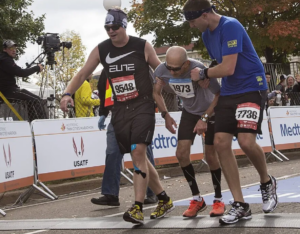Fueling Your Body – Carb-loaded vs Fat-fueled
Talking with a patient of mine recently who is soon to embark on a long backpacking trip reminded me of an important lesson I learned the hard way about how to fuel your body for an endurance event.
This young woman is actually going to the same place where I learned this hard lesson – a rugged mountainous wilderness area in the Southwest. It’s a grueling 12-day trek and an added challenge to carry one’s entire food supply on the trail. Essentially, this 12-day experience is an endurance event, a prolonged workout of moderate aerobic activity.
The advice given to her hiking group was to eat a lot of carbohydrates to give them enough energy for the hike.
“Trail meals are by necessity a high-carbohydrate, high-calorie diet rich in wheat, milk products, and sugars.” [Source]
Same advice as I was given 32 years ago. Here’s a typical meal –

Here’s the nutritional breakdown for this meal:
Calories: 900
Carbohydrates: 113 gm
–Sugars: 37 gm
Protein: 26 gm
Fat: 38.5 gm
The macronutrient percentages from that meal are 50% carbohydrate, 38.4% fat, and 11.5% protein.
Should I carb-load?
Historically, athletes have done carb-loading in anticipation of endurance events, with the reasoning that they want to load their glycogen stores to make more energy available to fuel their bodies. The concept of carb-loading was developed in the 1960’s with the intent of boosting athletic performance. This carb-loading ritual often means that runners indulge in a pasta dinner on the eve of a marathon or for several days leading up to an event. How effective is this method? To find out, let’s look at how energy is stored in the body.
Glycogen
All carbohydrates are comprised of glucose. Thus, when you consume carbohydrates, they break down to glucose. Glucose can be stored in the liver and muscle tissue as glycogen. Your liver can store about 100 grams of glycogen – equivalent to about 400 calories. Your muscle tissue can store about 350 grams of glycogen – equivalent to about 1600 calories. That gives you a total of 2000 calories stored as glycogen. That’s enough energy for a few hours of continuous, vigorous activity.
equivalent to about 1600 calories. That gives you a total of 2000 calories stored as glycogen. That’s enough energy for a few hours of continuous, vigorous activity.
Thus, there is a finite limit to how much energy can be stored as glycogen. If one’s body is capable of burning only glucose, then that person will “bonk” or “hit the wall” after depleting the 2000 calories of glycogen. In this situation, one would need to continually replace the glucose that is being burned, hence the popularity of high-sugar treats and gels used in endurance events.
Fat
Fat is a much more  efficient way to store energy. One pound of pure fat contains about 4,100 calories, whereas one pound of glycogen contains only 680 calories. For a relatively lean individual with 24 pounds of body fat, the equivalent energy in glycogen would weigh 144 pounds. The amount of energy stored as fat obviously depends on one’s fat mass. For the aforementioned lean individual, there is about 100,000 calories of energy stored as fat, which is adequate for about 100 hours of vigorous activity.
efficient way to store energy. One pound of pure fat contains about 4,100 calories, whereas one pound of glycogen contains only 680 calories. For a relatively lean individual with 24 pounds of body fat, the equivalent energy in glycogen would weigh 144 pounds. The amount of energy stored as fat obviously depends on one’s fat mass. For the aforementioned lean individual, there is about 100,000 calories of energy stored as fat, which is adequate for about 100 hours of vigorous activity.
Carb-loading among athletes
The age-old tradition of carb-loading may soon be seeing its end, as athletes discover the advantages of being fat-fueled. Elite athletes are adopting a low carb high fat lifestyle and recognizing performance advantages compared to the continuous high carb diets they previously employed. When eating low carb, endurance athletes note that they recover faster after races and have more stable energy levels.
A study on cycling performance over 100 km by Dr. Tim Noakes demonstrated no difference in performance between carb-loaded athletes compared to placebo.
There are downsides to carb-loading, as well. Carb-loading causes water retention, with 4 molecules of water attached to each molecule of glycogen. Many runners carry an excess of 2 kg of water weight due to this phenomenon. Also, there can be rapid swings in glucose levels that may result in a perception of improved performance initially and then a decline in performance when the glycogen is depleted.
“The worst advice given to . . . runners is to carbo-load.”, says Tim Noakes, MD.
Tapping into fat stores
Once an individual becomes fat-adapted, there is essentially no such thing as “hitting the wall”, as there is an abundance of energy available in our fat stores to fuel endurance activity. The body’s fat-burning machinery needs to be maintained or exercised. If one only ever  burns carbohydrates/sugars, then the fat-burning machinery gets rusty.
burns carbohydrates/sugars, then the fat-burning machinery gets rusty.
It was no surprise then that several years ago, I was able to complete a grueling 19-mile hike with minimal food intake . . . and no hunger. As a result of my low-carb lifestyle, my body was already well-adapted to utilizing fat as an energy source. Thus, when my body was depleted of glycogen within a few hours of hiking, it tapped into my fat stores without difficulty. That experience was drastically different from the high-carb, high-sugar backpacking experience 32 years ago, during which I was constantly craving more food.





